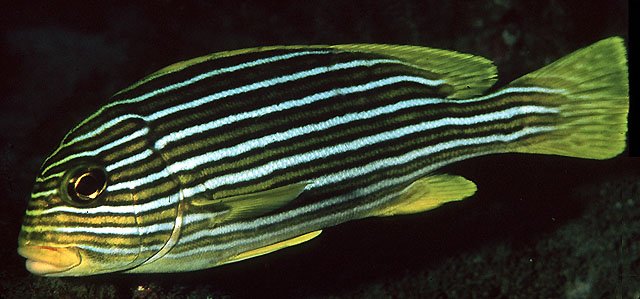| Haemulidae (Grunts), subfamily: Plectorhinchinae |
| 50 cm TL (male/unsexed) |
|
reef-associated; marine; depth range 5 - 40 m |
| Indo-West Pacific: west coast of India; Philippines and Indonesia to Papua New Guinea, south to northern Australia (Ref. 9710). |
|
Dorsal spines (total): 12-13; Dorsal soft rays (total): 19-22; Anal spines: 3-3; Anal soft rays: 7-8. This species is distinguished by the following characters: chin with 6 pores, no median pit; gill rakers on first gill arch 7-9 + 1 + 17-20 = 26-29; Dorsal XII (rarely XIII), 19-22, 3rd-5th spines longest; lips fleshy, moderately swollen with age; scales ctenoid (rough to touch); lateral line tubed scales about 54-60; body depth 2.6-2.9 in SL; caudal fin rounded to slightly emarginate. Colour: brown to yellowish grey with 5 to 9 fairly narrow grey or white longitudinal stripes outlined with dark brown on body and continuing around snout; fins yellow, soft dorsal, caudal, and pectoral fins with darker stripes disappearing with age; eye and lips yellowish; mouth, tongue, and gill rakers scarlet; chin white; juveniles have fins striped and fewer stripes on body (Ref. 47695, 90102). |
| Occurs on coastal and seaward reefs. Adults on deep, current-prone slopes with rich invertebrate growth; juveniles on sheltered reefs nearby (Ref. 48635). Found singly, in small groups under ledges or large resting aggregations by day, forages for small invertebrates at night (Ref. 9710, 90102). Caught throughout its range; not common. Rarely marketed in India (Ref. 3412). Taken by handline and spear. Marketed fresh, a small quantity is salted (Ref. 47695). |
|
Least Concern (LC); Date assessed: 28 June 2018 Ref. (130435)
|
| harmless |
|
Source and more info: www.fishbase.org. For personal, classroom, and other internal use only. Not for publication.

